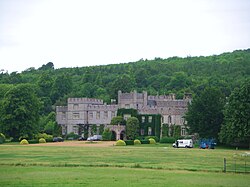West Dean, Sussex
| West Dean | |
| Sussex | |
|---|---|
 West Dean House | |
| Location | |
| Location: | 50°54’22"N, -0°46’37"W |
| Data | |
| Population: | 481 (2011[1]) |
| Post town: | Chichester |
| Postcode: | PO18 |
| Dialling code: | 01243 |
| Local Government | |
| Council: | Chichester |
| Parliamentary constituency: |
Chichester |
West Dean is a village and parish in Sussex, five miles north of Chichester on the A286 road just west of Singleton. The parish includes the hamlets of Binderton and Chilgrove.
The parish has a land area of 6,136 acres. The 2001 Census recorded 425 people living in 177 households. The village is on the Monarch's Way long distance footpath.
West Dean is in the Lavant Valley in the South Downs has a Church of England parish church and one public house, the Selsey Arms. The church and most of the houses are built of flint, in most cases with brick quoins and window dressings.
Parish church
The Church of England parish church of Saint Andrew is a Saxon building from before the Norman conquest.[2] It was badly damaged by a fire in 1934 but then sensitively restored under the direction of Frederick Etchells.[2]
Manor
The Domesday Book of 1086 records Binderton under Sussex in the lands belonging to Earl Roger. It says:
The Earl himself[3] holds Binderton. Countess Gytha held it. Then assessed at 7 hides but now three. There is land for four ploughs. In demesne there are two ploughs and eight villans with nine bordars with two ploughs. There are four acres of meadow and a church. TRE[4] it was woth 100 shillings then sixty shillings, now seven pounds.[5]
West Dean House
West Dean House is a Georgian "Gothick"[6] country house that now houses West Dean College, a specialist college with a world-wide reputation for the study of conservation, making and visual arts.[7] James Wyatt designed the house[6] and it was built in 1804[6] for Baron Selsey of the Peachey family. After the death of the last Peachey heir it became the home of William James in 1891 and in 1893 much of the house was remodelled to designs by Ernest George and Harold Peto.[6] His son Edward James, donated it to a charitable trust (the Edward James Foundation) in 1964 and it became a college in 1971. Peto also designed the walled gardens, which with the glasshouses and other gardens around the house are open to the public. There is also a park and arboretum.[8]
Landmarks
Kingley Vale is on the border of the parish and is a Site of Special Scientific Interest and a national nature reserve. It is noted for its yew woodlands.[9] The site is also of archaeological interest including Bronze Age and Roman earthworks, cross dykes, Goosehill Camp on Bow Hill[6] and an ancient field system.
References
| ("Wikimedia Commons" has material about West Dean, Sussex) |
- ↑ "Civil Parish 2011". http://www.neighbourhood.statistics.gov.uk/dissemination/LeadKeyFigures.do?a=7&b=11130339&c=PO18+0FG&d=16&e=62&g=6473571&i=1001x1003x1032x1004&m=0&r=0&s=1444829440286&enc=1. Retrieved 14 October 2015.
- ↑ 2.0 2.1 Nairn & Pevsner 1965, p. 368.
- ↑ Earl Roger held several manors in Sussex including Mid Lavant, Chichester, and Cocking.
- ↑ Tempore Regis Edward ie in the time of King Edward before the Norman Conquest in 1066
- ↑ Domesday Book, a complete translation, Ann Williams and GH Martin (Eds), p55, ISBN 0-14-051535-6, 2002
- ↑ 6.0 6.1 6.2 6.3 6.4 Nairn & Pevsner 1965, p. 369.
- ↑ West Dean College
- ↑ West Dean Gardens
- ↑ "SSSI Citation — Kingley Vale" (PDF). Natural England. http://www.english-nature.org.uk/citation/citation_photo/1002819.pdf. Retrieved 4 April 2009.
Sources
- Nairn, Ian; Pevsner, Nikolaus (1965). Sussex. The Buildings of England. Harmondsworth: Penguin Books. pp. 368–369. ISBN 0 14 071028 0.
